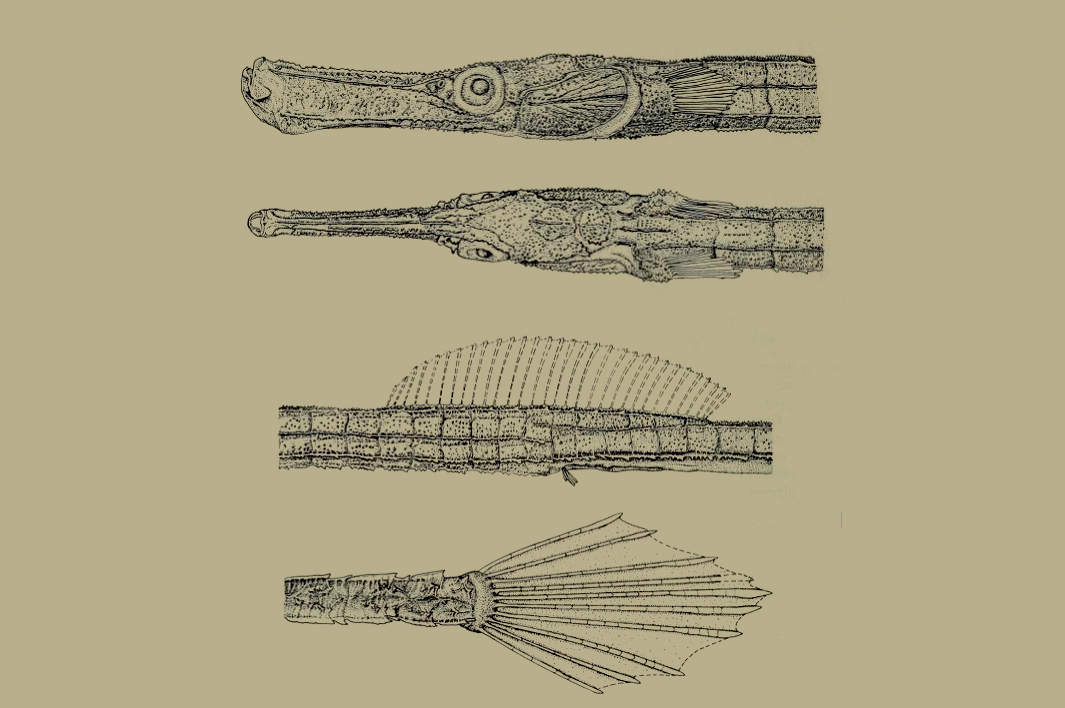Shaggy Pipefish, Hypselognathus horridus Dawson & Glover 1982

Illustrations of the holotype of the Shaggy Pipefish, Hypselognathus horridus - SAM F4676. Source: From Dawson & Glover 1982 Proc Biol Soc Washington 95(2):404. License: All rights reserved
The Shaggy Pipefish is endemic to the eastern part of the Great Australian Bight, and is characterised by having a very spiny head and body, a tail fin, the brood pouch on the tail and in lacking scutella on the body rings.
Shaggy Pipefish, Hypselognathus horridus Dawson & Glover 1982
More Info
|
Distribution |
|
|
Features |
Meristic features: Dorsal fin 29–32; Anal fin 3; Pectoral fin 10–13; Caudal fin 10; Trunk rings 27–28; tail rings 42–45; Subdorsal rings 7.00–6.00 + 4.00–5.50 = 11.00–11.75. Body very slender and elongate; trunk shallow; head aligned with body; body posterior to dorsal fin markedly longer than that before dorsal fin; body and head surfaces, excluding membranes, clearly spinulose; no wart-like scutella on body rings; long snout, length 55–67% HL; snout depth 17–23% snout length; opercle without distinct longitudinal ridge in subadults or adults; tail not prehensile. Single dorsal fin centred on back with base of moderate length; anal fin tiny, below front half of dorsal fin; caudal fin small, broadly pointed; pectoral fins small. |
|
Size |
|
|
Colour |
In preservative – overall greyish, peppered with minute brown or black spots; ring margins edged with black. Colour in life unknown. |
|
Feeding |
|
|
Biology |
Males brood the eggs in a pouch under the tail. The pouch has protective pouch plates and membranous folds, with an everted pouch closure. The brood pouch is developed in a male of 154mm SL, suggesting that males are brooding by this size. Brood pouches of three males examined contained 20, 60 and 80 eggs. The larvae are undescribed. The closely related species, Hypselognathus rostratus, has a long pelagic stage, with some planktonic individuals measuring up to 150mm. |
|
Fisheries |
|
|
Conservation |
Australian Commonwealth legislation: Marine listed under the Environment Protection and Biodiversity Conservation Act 1999 (EPBC Act). State Legislation: Listed as protected under the Fisheries (General) Variation Regulations 2006 of the South Australian Fisheries Act. |
|
Similar Species |
Hyselognathus horridus differes from H. rostratus in having spines on head and body surfaces at all sizes, versus having rounded, wart-like scutella on each body ring in larger juveniles and adults. H. horridus has a greater number of trunk and tail rings (27 and 42–45 versus 25 and 41–44), fewer pectoral fin rays (10–12 versus 12–14), and a deeper snout. |
|
Etymology |
Hypselognathus is from the Greek hypselos (high) and gnathos (jaw). The specific name horridus is from the Latin meaning bristly or rough, in reference to the spines on the head and body. |
|
Species Citation |
Hypselognathus horridus Dawson & Glover 1982, Proc. Biol. Soc. Wash. 95(2): 403, figs. 1-2, off Anxious Bay, Great Australian Bight, South Australia, depth 30 fms. |
|
Author |
Dianne J. Bray & Vanessa J. Thompson |
Shaggy Pipefish, Hypselognathus horridus Dawson & Glover 1982
References
Baker, J.L. 2009. Marine Species of Conservation Concern in South Australia: Volume 1 - Bony and Cartilaginous Fishes. Report for the South Australian Working Group for Marine Species of Conservation Concern. Web version published by Reef Watch, South Australia. http://www.reefwatch.asn.au/pages/bin/view/Publications/SamsccHome
Dawson, C.E. 1985. Indo-Pacific Pipefishes (Red Sea to the Americas). Gulf Coast Research Laboratory, Ocean Springs, Mississippi. 230 pp.
Dawson C.E. & Glover C.J.M. 1982. Hyposelognathus horridus, a new species of pipefish (Syngnathidae) from South Australia. Proc. Biol. Soc. Wash. 95(2): 403–407.
Kuiter, R.H. 2008. Family Syngnathidae (pp. 448–479). In Gomon, M.F., D.J. Bray & R.H. Kuiter. (Eds.) Fishes of Australia's Southern Coast. New Holland Press & Museum Victoria, Melbourne, Australia, 928 pp.
Kuiter, R.H. 2009. Seahorses and their relatives. Aquatic Photographics, Seaford, Australia. Pp. 1–333.
Paxton, J.R., J.E. Gates, D.F. Hoese & D.J. Bray. 2006. Syngnathidae (Pp. 810–846). In Beesley, P.L. & Wells, A. (Eds) Zoological Catalogue of Australia. Volume 35. Fishes. ABRS & CSIRO Publishing, Australia., 3 vols.
Pogonoski, J.J., D.A. Pollard & J.R. Paxton. 2002. Conservation Overview and Action Plan for Australian Threatened and Potentially Threatened Marine and Estuarine Fishes, Environment Australia, Canberra. 375 pp.



